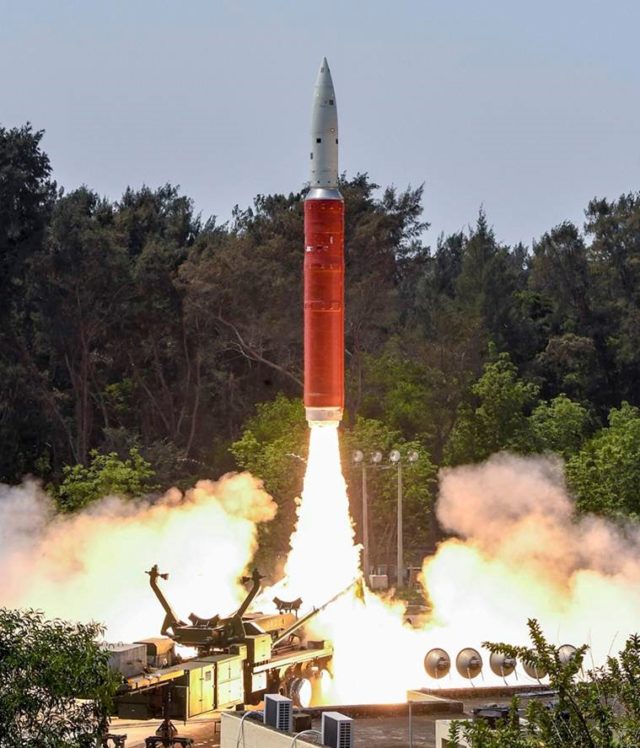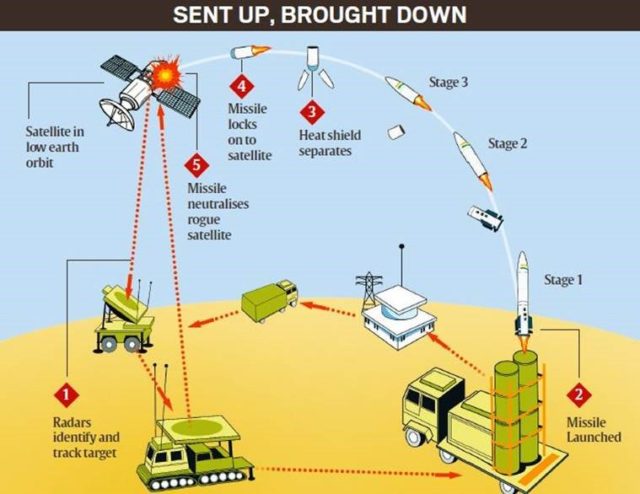PREVIOUS
MISSION SHAKTHI
April 4 , 2019
2204 days
3206
0
- Indian Prime Minister announced on March 27 2019 that the DRDO-developed anti-satellite system A-SAT successfully destroyed a live satellite in the Low Earth Orbit. With this test, dubbed as Mission Shakti, India is only the fourth country after the U.S., Russia and China to have the technology.

What are Low-Earth Orbit satellites?
- The Indian satellite that was shot down was a Low-Earth Orbit (LEO) satellite.
- These are satellites roughly at an altitude of 2,000 kilometres from the earth and that’s the region where majority of satellites are concentrated.
- A database from the Union of Concerned Scientists, a non government organisation based in the United States, says that there are at least 5 known Indian satellites in LEO: India PiSat, Resourcesat 2, Radar Imaging Satellites 1 and2 and SRMsat.
What are anti-satellite (ASAT) weapons?
- They are missile-based systems to attack moving satellites.
- So far, the United States, China and Russia were the only ones who’ve reported the ability to shoot down space objects from ground or airborne sources.
- The development of such systems has a long history — fuelled by the Cold War between the United States and the former Soviet Union.
- There are different kinds of systems — those that can be launched from the ground or those vaulted from planes.
ASAT worldwide
- In the Cold War/Space Race era, 1985 was the last time that the United States had used an anti-satellite system to destroy its P-781 satellite that had instruments aboard to study solar radiation.
- Anti-satellite weapons came back into popular currency after China conducted an anti-satellite missile test on January 11, 2007.
- The Chinese government officially confirmed this only on the January 23, after reports in several US media.
- The target was a Chinese weather satellite — the FY-1C – that sailed at an altitude of 865 kilometres (537 mi).
- A year later, the United States launched ‘Operation Burnt Frost,’ the code name to intercept and destroy a non-functioning U.S. National Reconnaissance Office (NRO) satellite named USA-193.
What are India’s capabilities so far?
- While 'Mission Shakti' may have targeted an object in outer space, India has long developed the ability to intercept incoming missiles.
- In 2011, a modified Prithvi missile mimicked the trajectory of a ballistic missile with a 600-km range. Radars at different locations swung into action, tracking the “enemy” missile, constructing its trajectory and passing on the information in real time to the Mission Control Centre (MCC) to launch the interceptor, an Advanced Air Defence (AAD) missile.
- It had a directional warhead to go close to the adversarial missile before exploding to inflict damage on it.
India’s ASAT
- The scientists and engineers at Defence Research and Development Organisation (DRDO) launched a missile from the Dr A P J Abdul Kalam Island launch complex near Balasore in Odisha.

- It struck a predetermined target: a redundant Indian satellite that was orbiting at a distance of 300 km from the Earth’s surface.

- The official sources said the satellite that had been knocked out was Microsat R, a micro-satellite launched by ISRO on January 24 this year. The satellite was manufactured by DRDO.
History of ASAT in India
- ‘Mission Shakti’ is an operation that demonstrated India’s anti-satellite missile capability by shooting down a live satellite.
- India’s ASAT development has a long history with Dr V.K. Saraswat, Director-General of the Defence Research and Development Organisation.
- He stated in 2012 that India had "all the building blocks necessary" to integrate an anti-satellite weapon to neutralise hostile satellites in low earth and polar orbits.
Why we need ASAT?
- The technology is aimed at destroying, if necessary, satellites owned by enemy countries.
- A large number of crucial applications are now satellite-based.
- These include navigation systems, communication networks, broadcasting, banking systems, stock markets, weather forecasting, disaster management, land and ocean mapping and monitoring tools, and military applications.
- Destroying a satellite would render these applications useless.
- It can cripple enemy infrastructure, and bring it down on knees, without causing any threat to human lives.
Why few countries have it?
- It requires very advanced capabilities in both space and missile technologies that not many countries possess.
- Also, destroying space infrastructure like satellites is also taboo in the international community.
- There is international mandate that outer space, and celestial bodies like the Moon, must only be exploited for peaceful purposes.
Outer Space Treaty of 1967
- India is a signatory of Outer Space Treaty of 1967.
- It prohibits countries from placing into orbit around the Earth “any objects carrying nuclear weapons or any other kinds of weapons of mass destruction”.
- It also prohibits the stationing of such weapons on celestial bodies, like the moon, or in outer space.
- According to the treaty, “The moon and other celestial bodies shall be used by all state parties to the treaty exclusively for peaceful purposes.”
Space Junk/ Space debris
- There is a more compelling and practical reason for countries not wanting to destroy each other’s satellites — the problem of space debris.
- According to the European Space Agency, there were an estimated 7,50,000 objects of size one cm or above in space.
- A satellite that is destroyed by a missile disintegrates into small pieces, and adds to the space debris.

- Space debris could collide with the operational satellites and render them dysfunctional.
- When China carried out its first anti-satellite missile test in 2007, destroying its Fengyun-1C weather satellite, it created more than 2,300 large pieces of space debris and an estimated 1.5 lakh pieces of objects that were larger than 1 cm in size.
- Each of them could render a satellite useless on collision.
Indian test and Space debris
- The Ministry of External Affairs, in its statement, said the Indian test was done in the lower atmosphere to ensure that there was no space debris.
- - - - - - - - - - - - - - -
Leave a Reply
Your Comment is awaiting moderation.


